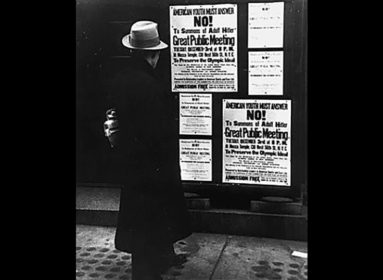By Eric Rozenman
In Nathaniel Hawthorne’s The Scarlet Letter, protagonist Hester Prynne must wear an “A” – for adultery – highlighting a sin not solely her own. So marked, she exists on the fringe of Puritan society.
Israel, smeared with the “D” of dispossession, often finds itself forced to the diplomatic and intellectual margins for its purported original sin – expelling the Arabs of Palestine. So powerful is this fraudulent indictment that it appears in a new Jewish memoir, The Family: Three Journeys into the Heart of the Twentieth Century (David Laskin, Viking).
While Hawthorne’s heroine was more sinned against than sinning, Israel is altogether innocent of the crime anti-Zionists allege. Nevertheless, puritanically rigid accusers, whether post-liberal left, anti-Semitic far-right or Arab-Islamists, have insinuated their charge even into Jewish consciousness.
Washington Post reviewer Jonathan Yardley, summarizing Laskin (“A century of success and sorrow,” Oct. 27), says one group of the author’s relatives “had gone from Poland to British Mandatory Palestine in the 1920s, raised a family and became witnesses to, and participants in, ‘the tragedy of modern Palestine … that one oppressed, thwarted people had come to settle among, and inevitably to displace, another oppressed, thwarted people.’” Here seductive parallelism slides into deceptive equivalence. But only the Jews in this case were an oppressed, thwarted, displaced and largely annihilated people.
Arabs participated in the oppression and annihilation. According to Yardley’s review, both he and Laskin indirectly refer to this fact without recognizing it. Of the author’s family that stayed in Lithuania, “by the late 1930s, ‘Vilna’s Jewish residents and refugees had little hope of securing sanctuary in the United States or anywhere else in the world. The ranks of those who succeeded were tiny …’
”After the Nazi occupation in 1941, “Vilna, ‘with its combustible mix of cultured Jews, anti-Semitic Lithuanians and stateless Poles, became a kind of laboratory for Nazi terror and mass murder.’” Of the city’s 80,000 Jews, approximately 77,000 were killed, among them 17 members of Laskin’s family.
Why hadn’t they been able to join their relatives in Palestine? Because Arab pogroms of 1920 and 1929 and the uprising of 1936-1939 helped convince British authorities virtually to end Jewish immigration. Never mind that this contravened London’s pledge to administer the Mandate so as to assist the Zionist movement in re-establishing the Jewish national home. By helping trap Europe’s Jews in the Nazi maelstrom, Palestinian Arabs under Haj Amin al-Husseini, the British-appointed Grand Mufti and Adolf Hitler’s wartime ally, were complicit in the Holocaust. A decade before the Arab nakba, the “catastrophe” of Israel’s creation, Palestinian Arabs helped foster European Jewry’s destruction.
And there was more to what Laskin calls, according to Yardley, the “tragedy of modern Palestine.” The Jewish remnant there expelled comparatively few Arabs, and those in the context of a war for survival. Before Israeli independence, Zionist development had attracted large numbers of Arab migrants, as noted in studies by Fred Gottheils, Arieh Avneri and others. Hence the U.N. Relief and Works Agency’s decision to grant “refugee” status to any fleeing Arab who claimed at little as two years residency in what became Israel.
The large majority of Arab refugees were self-dispossessed by Arab actions. Had the Arab states and Palestinian Arab leadership not rejected the 1947 U.N. partition plan; had they not gone to war in 1948 despite the U.N. vote to create a Jewish state and a second Arab state in what originally had been Mandatory Palestine (Transjordan, today’s Jordan, was the first); and had they not failed in their attempt to destroy the infant Israel, there would have been no Arab refugees.
Arab culpability for “the tragedy of modern Palestine” does not end here. Between roughly 400,000 and 600,000 Arabs – the former estimates by U.N. and Israeli officials at the time, the latter the difference in Arab populations between the last British and first Israeli censuses – were displaced to other parts of Palestine or nearby Arab countries as a result of actions by their leaders. Meanwhile, approximately 850,000 Jews fled or were expelled from Arab countries, many from centuries-old communities and who left behind property of much greater value than that abandoned by Arab refugees. Nearly 600,000 settled in Israel. Arab-Israeli peace will not be built on lies. In any truth and reconciliation process preceding the conflict’s end, Arabs should concede who dispossessed whom.
Eric Rozenman is Washington director of CAMERA, the Committee for Accuracy in Middle East Reporting in America. This article first appeared in the Washington Jewish Week.








 Southern New England Jewish Ledger
Southern New England Jewish Ledger








